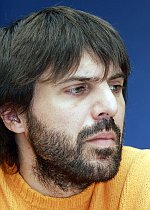In depth
Nonviolence, a tool for transformation
Nonviolence is a very strong force. The word comes from the Sanskrit (ahimsa) and describes both a philosophy of life and a specific way of achieving political and social change. Its distinguishing feature, as the word suggests, is rejection of the use of violence, but this rejection does not imply resignation or submission, but instead quite the opposite. Nonviolence carries out actions of resistance or civil disobedience in order to achieve its objectives. It has strong links with pacifism, but the two terms are not synonymous. Pacifism is not necessarily linked to a desire for change, but instead emphasises a rejection of violence. However, there is an implicit objective of social and political change in nonviolent action.

Pablo Aguiar
The events in North Africa and the Middle East in recent weeks are a good example of nonviolence. Despite the fact that those events are not the subject of this article, I believe a few short comments are necessary.
Because all types of commentators and media warn us constantly of the need for armies - and of the uselessness, ineffectiveness and slowness of nonviolent alternatives - we need to hold our heads high on occasions like this. We need to educate and undertake an empirical demonstration by example. Society in Egypt and Tunisia has succeeded in quickly - so far on a nonviolent basis - changing governments that had refused to move for over three decades. The levels of discontent are so high that without any foreign support, and with practically no organisational structure, it has only taken a spark to make people to take to the street and to make their respective governments totter. Quickly and effectively ... and nonviolently. We need to emphasise this!
Finally, to end this short discussion of current events, I have another thought. If these events have been a problem for anyone, it is the Western powers, which were willing to sacrifice respect for human rights and democratic principles in return for a guarantee of stability, advantageous trade policies and energy supplies, in some countries. Their rhetoric - they have always considered themselves lifelong democrats - has shown scrupulous respect for pluralist systems. Their actions and those of those they supported suggested quite the opposite. Hopefully their rhetoric will continue, but from now on they will decide to make a real effort towards consistency. It is obvious - but it also needs to be remembered - that these governments act in our name and represent us.
Returning to the subject that concerns us here, nonviolence includes a variety of mechanisms aimed at social transformation. Using these mechanisms does not guarantee victory, or that the objectives of the transformation may be considered positive. What is certain is that if one of the two parties to a conflict uses violence, the opportunities for resolving it, or positive transformation, are drastically reduced.
It is also true that in Catalonia there have been many individuals and organisations who have advocated nonviolence as a means for transformation. Indeed, one of those people, Pepe Beunza, is featured in our interview. But taking advantage of this wealth and diversity in the nonviolent tradition in Catalonia, we also thought it appropriate to include an article on this subject written by another of the central figures in the movement, Jaume Botey.
Continuing the theme of returning to the roots and discovering the sources, we have an article by Pere Ortega, who reviews the tradition of nonviolent thought and its central figures, and gives us a summary.
The second part of the articles focuses on putting nonviolence into practice. The first, by Luca Gervasoni, makes a necessary distinction for the uninitiated. Nonviolent resistance and pacifism is not the same thing, although they may coincide, particularly in inspiring principles rather than in practice. He highlights two of the recurring features in studies of the impact and effect of nonviolent resistance.
The second article focuses on its application. In a monograph on nonviolence, we thought it essential to include a first-hand account of how these types of actions are prepared, which precautionary measures must be taken, and some of the risks involved in carrying them out. Carlos Pérez, of Alternativa Antimilitarista - MOC Valencia has written for us about the protests against the NATO summit that took place in Lisbon last November.
Finally, although this is not a news magazine, the importance and dimensions of the white uprisings force us to examine the subject from the perspective of nonviolence. Rafael Grasa does so in an article in which he considers nonviolent resistance movements and to what extent their intellectual inspiration can be attributed to Gandhi or La Boétie.
This series of articles aims to bring together various analyses of nonviolence in order to make it more visible and understandable. The texts reflect this and have the added value that they have also all been written by activists. As well as their knowledge, they also contribute their involvement in this mechanism for social and political transformation.